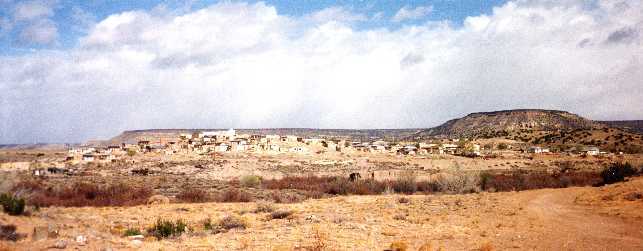Villages at Santo Domingo and San Felipe Pueblos, for example, aren't visible from the highway, but are from the train.
Planners say much of the rail corridor between Santa Fe and Albuquerque crosses pueblo lands.
Because of that exposure, Santo Domingo and San Felipe have asked that conductors instruct passengers not to take pictures while the state-run trains, which started service in December, pass through their lands.
In 2003, the makers of Lay's potato chips released a new "Santa Fe Ranch" flavor. These were marketed in a bag that bore an image of what appeared to be a Navajo woman in front of Taos Pueblo.
On the one hand, you have passengers in a government-run public conveyance. Should governments ever prohibit behavior that doesn't disturb the peace? As a journalist, this seems like a rights issue to me. My freedom of the press is limited if I can't take pictures in a public setting.
On the other hand, there are the Pueblos' request to refrain and the reasons for it. I've obeyed their prohibitions against photography when I visited them.
This article doesn't answer some key questions. Does the state have the right to run trains through Pueblo lands? Can the Pueblos do anything to stop or reroute these trains? Did they try these tactics, or did they agree to the trains' passage?
Also, the talk of misused pictures of Taos is misleading. Taos isn't on this train route, and no other tribe has buildings as photogenic as Taos's.
What can you actually see from the train? A plaza where religious ceremonies are held? A sacred site or picturesque landmark? Someone's backyard or bedroom?
If we're talking about exposing something truly private to public scrutiny, then I'm sympathetic. If we're talking about exposing a barren landscape with a few tiny buildings in the distance, then I'm somewhat less sympathetic.
Case study
Below is a presumably legal photograph of Laguna Pueblo outside Albuquerque. No rules or signs that I know of prohibited this photo, which I believe I took from a distant road.
Do you think someone is going to use this photo on a postcard or in a potato-chip commercial? I strongly doubt it.
I'd say this doesn't invade anyone's privacy any more than an image from a plane or a satellite does. It's an impersonal, almost abstract vista, nothing more.
For more on the subject, see Who Owns Native Culture? and Who Controls Old Photographs?


No comments:
Post a Comment